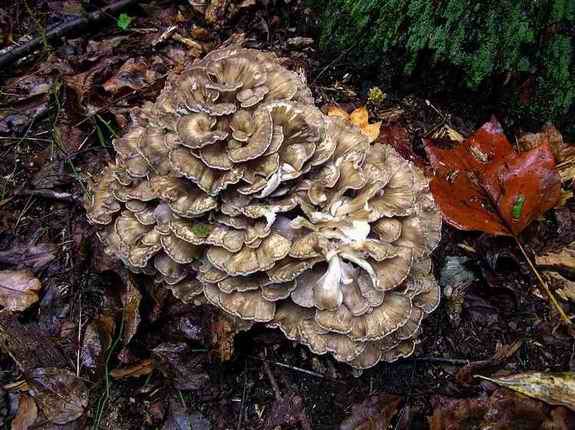|
Return to Hiker's Notebook Home Page
Common Name: Hen-of-the-Woods, Sheep's head; Maitake (Japan); Klapperschwamm and Laubporling (Germany); Poule des bois, Pied de griffon, and Polypore en touffe (France); Fungo imperiale and Griffo (Italian) - The shape and the colors of the clusters of overlapping caps of the polypore fruiting body are suggestive of the feathers of a hen; the configuration also bears some resemblance to a Sheep's head.
Scientific Name: Grifola frondosa - The generic name is from griffin, a mythical beast with the head and upper body of an eagle with the lower body of a lion, popular in heraldry. The front legs of the griffin are typically depicted as being covered with the layered feathers of the eagle; the genus name was thus also chosen to reflect the avian appearance of the hen-of-the-woods (note that one of the French names is pied de griffon, foot of the griffin). This is etymologically ironic in that the name griffin is from the Greek word grypos which means curved, supposedly for the curved beak of the griffin. Frondosa is the Latin word for full of leaves, this to characterize the leaf-like caps of the fruiting body.
The Hen-of-the-woods is an imposing polypore that can grow up to two feet in diameter and weigh up to 80 pounds, though sizes of six to twelve inches in diameter and 4 to 6 pounds are more common. It is saprophytic, growing on stumps or at the base of dead or dying deciduous trees, notably oak. It is one of the most delectable of the edible fungi; its numerous names in diverse languages testify to its universal notoriety and appeal.
The Japanese name for Hen-of-the-woods is Maitake, a combination of the words mai which means dancing and take which means mushroom. The probable explanation of the etiology of the "dancing mushroom" is that the caps or leaves of the fruiting body resemble dancing butterflies, a popular Asian cultural metaphor. An alternative theory holds that the lucky mushroom hunter who found a Maitake would literally dance with the joy of discovery in anticipation of a uniquely satisfying gastronomic experience. The latter has some merit as G. frondosa has been lauded as near ambrosia in Japan and China for millennia; while its relative scarcity may have eliciting a mushroom dance celebration. The Maitake was so revered in Japan that it was worth its weight in silver; it was offered to the Shogun by the local warlords as a special gift.
Like most edible fungi, the Grifola frondosa is nutritious, containing significant amounts of proteins, vitamins and minerals. Since it is mostly water (91 percent), its constituents are accordingly determined and reported as a percentage of dry weight. The protein content of 19.7 percent is about average compared to other edible fungi; the button mushroom (Agaricus bisporus) is somewhat higher at 27 percent while the wood ear (Auricularia auricula) is significantly lower at 4 percent. The type of protein is more important, however. Adults need 8 essential amino acids, those that must be ingested directly and cannot be concocted from other constituents. Those commercially grown mushrooms that have been analyzed have all eight essential amino acids; it is likely that Maitake does as well. It has significant amounts of vitamins B1, B2, ergoserol (provitamin D), potassium and phosphorous.
Grifola frondosa has been used in traditional Asian medicine for centuries to promote general health and vitality by enhancing the responsiveness of the immune system. In the early 1980's the Japanese mycologist Hiroaki Nanba of the Pharmaceutical University of Kobe began investigating the Maitake to determine the chemical nature of its alleged medicinal properties. Based on the extraction of various polysaccharides and animal testing for antitumor and immunological effects, he concluded that one polysaccharide subsequently named beta-D-glucan was particularly adept at stimulating macrophages or killer cells. Maitake is currently under review for the treatment of cancer, diabetes and Acquired Immune Deficiency Syndrome or HIV-AIDS.
Human clinical studies are in progress to evaluate the efficacy of beta-D-glucan, also known as the D-fraction, in the treatment of breast and colorectal cancer. This trial is a consequence of successful animal laboratory trials in which mice were alternately treated with a carcinogen for urinary bladder carcinoma and the Maitake extract. Those that were subject to the carcinogen alone all had bladder carcinomas, while less than half of those treated with beta-D-glucan were cancerous. Trials with diabetic laboratory mice also demonstrated that Maitake lowered the blood glucose levels. It is hypothesized that a second high-molecular polysaccharide called the X-fraction is responsible for the reduction in insulin resistance. The ability of the D-fraction to stimulate macrophages that are important in the operation of the immune system led to its consideration as a potential AIDS drug. Studies are in progress at the Memorial Sloan-Kettering Cancer Center in New York and other institutions to determine the efficacy of the D-fraction of the Maitake in this application. |
